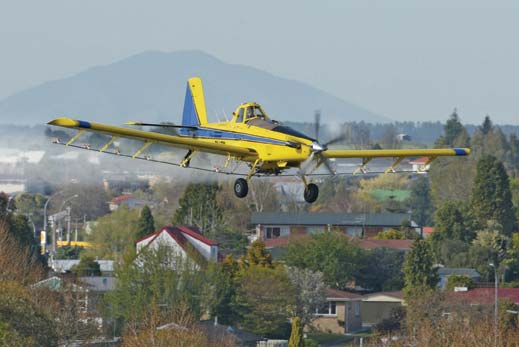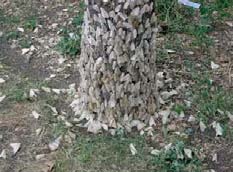PESTS AND DISEASES OF FORESTRY IN NEW ZEALAND
$80 million pest eradicated
from Biosecurity 61, August 2005.
In May 2005, Biosecurity New Zealand declared the Asian gypsy moth eradicated from New Zealand. It has been estimated that gypsy moth would cause economic impacts of up to $80 million/ annum if it established in this country.

An eradication programme had been implemented following the capture of a gypsy moth for the first time within New Zealand. Gypsy moth is regarded internationally as a high impact pest that causes serious environmental and economic damage throughout many parts of the world. Larval damage severely weakens and reduces tree growth, and hairs on the caterpillars cause skin irritation.
Increased risk from used car imports
The then Ministry of Agriculture and Forestry Biosecurity Authority initiated actions in March 2003, when a male gypsy moth was reported from a trap placed as part of the national gypsy moth trapping programme. This programme was established in 1993 in response to ships and cargo entering from the Russian Far East. More recently, the increase in imported Japanese used cars raised the risk of gypsy moth entering New Zealand. Traps are deployed throughout New Zealand and are focused on ports, and specified high risk places such as devanning (unloading) sites, container yards and imported car storage yards.
The initial response involved a ground search to a radius of 750 metres around the find and placing pheromone (disparlure) traps in a grid pattern out to a 7km radius. Movement controls were placed on vegetation from a defined area. These actions were aimed at delimiting the population and controlling the gypsy moth’s potential spread.
Japan confirmed as source
A trace back on the likely source of entry into New Zealand concluded that the gypsy moth probably originated from Japan, arriving as an egg mass with an imported used car. DNA profiling confirmed the origin of the trapped moth was Japan. It was identified as the Asian biotype, Lymantria dispar spp. praeterea.

A Technical Advisory Group (TAG) was convened to assist Biosecurity New Zealand by providing scientific and technical advice. On assessment of the evidence, the Technical Advisory Group recommended that Biosecurity New Zealand proceed with eradication of the gypsy moth.
The TAG agreed that other males and females from the same egg mass could have mated and the females laid new egg masses. It was agreed that other moths could have hatched, mated, laid eggs and that a population could well establish and expand from the egg mass. Even based on one male moth being trapped, it was agreed that without treatment there was a strong likelihood of a population of gypsy moth surviving into the second year.
Spraying, trapping programme
Aerial spraying with Btk (formulation Foray 48B) at the rate of 5 to 7 litres/hectare, followed by high-density trapping was recommended. Aerial spraying provides the best method to cover a wide area in a short time; it had been used previously over urban environments, and is a proven eradication technique against the gypsy moth.
During the predicted early instar stage of the gypsy moth in New Zealand (October/November) eight aerial applications of Foray 48B were applied at weekly intervals over an area of 1253 hectares in West Hamilton. No significant issues were encountered with the aerial treatment, and fortuitous weather meant that applications were completed within targeted timeframes.
After the completion of aerial treatment the focus of the eradication programme was on monitoring to detect any remnant gypsy moth activity. Additional traps were placed and further ground searches completed. The controlled area was maintained to ensure that untreated vegetation remained within the Hamilton region. No further activity was found.
Eradication successful
On 10 May 2005 the TAG met and concluded unanimously that, based on no sign of activity for two generations following aerial treatment, Asian gypsy moth could be declared successfully eradicated from Hamilton. Biosecurity New Zealand agreed with the recommendation, and an official declaration that eradication had been achieved was made by the Minister for Biosecurity on 26 May 2005.
Now the response has been completed, Hamilton will again be included within the national gypsy moth surveillance programme, with traps being placed on an annual basis around predetermined high risk sites between November and April.
Biosecurity New Zealand wishes to thank the many people and organisations who assisted in the successful eradication programme. The cooperation of the Hamilton community and scientific advice provided by the Technical Advisory Group was critical to the successful eradication of the Asian gypsy moth from New Zealand.
Mark Ross, Senior Adviser Surveillance and Incursion Response (Plant Kingdom), Biosecurity New Zealand,
phone 04 498 9611, fax 04 470 2741, mark.ross@maf.govt.nz

 Farm Forestry New Zealand
Farm Forestry New Zealand

